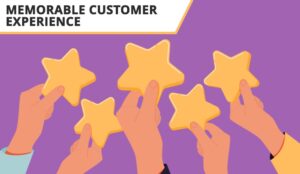Jennifer Wilson at NICE takes a look at the ins and outs of providing enhanced customer experience.
As competition becomes more and more fierce, it’s critical that brands have a well-designed strategy for providing enhanced customer experience.
Customer experience (CX) is the perception a consumer has about a business based on a cumulative set of interactions and impressions that can range from a retail store shopping experience to an organization’s Instagram post.
Because there are currently so many ways to influence customer opinions, companies should strive to impress throughout the customer journey.
One way to do that is to focus on delivering enhanced customer experience that engages customers, personalizes their interactions, and provides convenience and low effort through streamlined processes.
Consistently satisfying customers with superior CX is a difficult task due to the number of variables involved, but brands that relentlessly focus on innovation and meeting shifting customer expectations can capture higher customer loyalty and lifetime value, lower service costs, and more customer referrals. These outcomes ultimately contribute to improved financial performance.
The Pillars of Enhanced Customer Experience
A successful customer experience strategy is built on a foundation of characteristics that consumers value in a relationship with a business.
Businesses that want to be customer experience leaders should focus on strengthening the three pillars of enhanced customer experience: personalization, efficiency, and engagement.
When brands personalize experiences, they are demonstrating to customers that they understand their needs and preferences based on the history of the relationship.
Personalization can be as simple as a customer service agent using a customer’s name during a conversation or as complex as providing tailored, adaptive customer journeys based on the current intent or even previous experiences.
Effective personalization requires leveraging customer data, such as purchase history or demographics, to create uniquely enhanced customer experience.
Consistent and satisfying CX isn’t possible without efficiency. Consumers value convenient and frictionless transactions, such as ones provided by well-designed e-commerce sites and always available digital self-service.
Businesses also need to streamline internal processes that directly impact CX and ensure more efficient journeys, such as order fulfillment and agent scheduling. Organizations should strive to be easy to do business with by keeping required customer effort to a minimum.
The third pillar—engagement—may be the most difficult to achieve. Engagement is about creating emotional connections with customers to strengthen relationships and influence decisions.
People should feel good about transacting with a business, which can be accomplished with tactics such as acting on customer feedback, providing added value through generous loyalty programs, and creating content that helps customers get the most value from their purchases.
Let’s take a closer look at each pillar.
Personalization as the Core of Enhanced Customer Experience
Businesses can’t afford to treat their long-term customers like strangers every time they interact, and that’s why personalization is so important.
Whether it’s making relevant product recommendations or acknowledging birthdays, personalization lets customers know they are recognized, valued, and understood.
Successful personalization requires leveraging customer data from an abundance of sources. This information may include purchase history, product returns, contact centre interactions, product reviews, and more.
One of the best ways to get the most value from this data is to consolidate it and continuously analyze it with solutions powered by artificial intelligence (AI).
Artificial intelligence is well-suited for making sense of large quantities of information. It can identify patterns and make predictions about customer behavior.
It’s also a valuable tool for customer segmentation, assigning customers to groups based on various behavioral and demographic factors. This aids in personalization, especially when a customer doesn’t have a long history with a business.
With AI-generated insights, businesses can send emails and texts with more targeted offers and provide recommendations online that match customer preferences.
These insights can also drive content creation so that blog posts and videos match customer interests. And this content can be dynamically served to users based on their customer segment.
Streamlining Processes for Efficiency
Customer experience management efforts should be focused on providing seamless end-to-end customer journeys, regardless of the customer’s goals or the channels they use. Today’s journeys are nonlinear, and customers frequently take different paths to the same destination.
Regardless of what path they’re on or what phase of the journey, customers expect smooth sailing. Friction and barriers could damage customer retention.
This highlights the importance of efficiency. The following are actions organizations can take to streamline CX and operations in order to provide enhanced customer experience.
Omnichannel interactions
Digital consumers often use multiple channels for a single customer service issue. For example, a customer may begin their support journey by searching an online knowledge base, escalate to a virtual agent, and finally end with a phone agent.
An omnichannel experience makes these channel transitions seamless by making customer data and context available in every support channel.
Technology Investments
The right technical solutions not only enable omnichannel experiences but can also add process efficiency and empower businesses to make timely, data-driven decisions.
For example, automation tools can multiply resources and eliminate errors, while systems such as feedback management, customer relationship management, and AI analytics enable organizations to efficiently collect, store, and analyze information so they can make timely decisions and continuously innovate.
Employee Development
Customers still value satisfying human interactions, so in addition to investing in technology, businesses should also invest in their people.
Knowledgeable frontline workers are more likely to provide quick and accurate information, which adds efficiency to contact centre operations and improves first contact resolution rates. This topic will be discussed in more detail later in this article.
Other ways to strengthen this pillar of enhanced customer experience include optimizing internal processes, encouraging cross-team collaboration, improving inventory management, and streamlining the checkout process.
Engagement Strategies for a Memorable CX
According to one study by Gallup, about 70% of decisions are based on emotional factors and only 30% are based on rational factors.
This fact makes it crucial for brands to design experiences and messages that appeal to people’s emotions and make them feel good about doing business with a company.
Organizations can employ a number of tactics to provide enhanced customer experience that resonates with people’s emotions, including the following:
Storytelling
Telling a heartfelt or humorous story about the business and its customers can be an effective way to provide meaningful engagement.
Chick-fil-A does this well in its TV ad campaign where employees and customers sit on a couch and reminisce about a meaningful moment they had together.
Community Building
Some products lend themselves well to community building. For example, Winnebago Revel owners love their camper vans and meet annually for a rally to socialize with other “Revelers.”
Winnebago sponsors a booth and uses the opportunity to showcase new products, hand out swag, and collect customer feedback.
Humanize Interactions
Customers still appreciate interactions that aren’t cold and robotic. Human agents should show empathy and understanding when a customer has an issue, and even chatbots and virtual agents can be trained to demonstrate human characteristics such as humor and compassion in the right situations.
Feedback and Engagement
Businesses can demonstrate that customer opinions are important by regularly collecting and acting on customer feedback.
This isn’t just for show; incorporating customer input into customer experience enhancements will ensure that businesses are focusing on the right improvements.
Additionally, allowing customers to post photos on product reviews can increase engagement by letting customers demonstrate how they’re using their purchases.
Leveraging Technology to Elevate Customer Experience
An essential component of delivering enhanced customer experience is leveraging advanced technology.
Modern technical solutions enable effective self-service, personalization at scale, real-time insights, and more. Some of these tools include the following:
Virtual agents
Smart, AI-powered virtual agents have taken self-service to the next level. Because they can understand natural language, context, and intent, they can better understand user’s questions and issues and provide relevant responses. And because they’re available 24/7, they provide the convenience consumers value.
Interaction Analytics
Issues can appear out of nowhere and quickly become wildfires. Enhanced customer experience requires organizations to be able to rapidly identify emerging problems and stop them in their tracks.
Tools such as interaction analytics can analyze all customer service interactions in real-time and alert agents and managers about anomalies such as new contact drivers and decreases in customer sentiment.
Predictive Analytics
Predictive analytics, another solution that leverages AI, helps businesses provide proactive support and personalized experiences by predicting customer behavior.
By anticipating needs, companies can provide relevant offers and recommendations to their customers.
Internet of Things (IoT)
Connecting appliances, thermostats, watches, and other devices to digital services offers convenience and may increase customer satisfaction and loyalty.
On the horizon, virtual and augmented reality will increase engagement for enhanced customer experience.
The Role of Employee Training in CX Enhancement
Using the latest technology is only one variable in the CX equation. Enhanced customer experience also requires knowledgeable and capable employees.
A well-trained worker is more likely to give correct information, which will help satisfy customers, build trust, and enhance a brand’s reputation.
Trained employees also add consistency to the customer experience by following standards and performing processes according to design. Investing in their development can also make workers more engaged and committed to taking care of customers.
When designing a curriculum for employee development, companies should consider including the following topics:
- Soft skills—Soft skills include empathy, problem solving, rapport building, and emotional intelligence, and help frontline employees make loyalty building connections with customers and prospects.
- Product knowledge—Thorough knowledge of their company’s products allows employees to provide accurate information and more easily identify upsell and cross-sell opportunities.
- Technology—Employees need to be proficient in the systems they use so they focus on customers rather than fumbling though software.
Depending on the employee’s role, businesses may also want to provide training on customer journey mapping, cross-team collaboration, complaint handling, and cultural sensitivity.
Overcoming Challenges in CX Enhancement
If consistently delivering enhanced customer experience was easy, everyone would be doing it. However, studies show that consumers think many businesses are falling short of their CX promises.
A host of internal and external factors are working against brands that want to become customer experience leaders. Here are just a few of them:
Silos
Organizational and data silos are the enemies of exceptional customer experiences. CX depends on everyone in the business collaborating to support the customer experience strategy.
And because customer experience improvements and techniques such as personalization are highly data driven, customer information from multiple systems needs to be easy to access.
To overcome territorial issues, companies should reward collaboration and assign common goals. Data silos may need to be addressed by technology investments.
Lack of a Customer-Centric Culture
If employees don’t buy into the goals of the customer experience strategy, it won’t be successful. Becoming a CX leader requires a culture that’s focused on understanding and responding to customer needs and preferences.
Changing an organization’s culture is a difficult task but businesses can begin the cultural shift by aligning performance goals and recognizing and rewarding customer-centric behavior.
Resistance to Change
Becoming fully centered on the customer often involves wide-sweeping changes to technology, organizational structures, and roles and responsibilities.
Companies should be sensitive to the stress these changes can cause and address resistance with frequent and relevant communication.
Resource Constraints
Enhanced customer experience initiatives can be costly and resource-intensive to implement. Businesses may need to prioritize CX projects based on which have the best ROI or largest, positive impact on the customer.
Success Stories of Enhanced CX
None of the previously discussed barriers are insurmountable, as proven by these CX leaders:
- Costco—The warehouse retail chain has won loyal customers with its vast product selection, value pricing, and friendly service. For the fiscal year 2023, this resulted in an impressive year-over-year 9.5% growth in revenue.
- Nordstrom—Nordstrom has secured a reputation of high quality and customer focus. This high-end retailer has secured customer loyalty through enhanced customer experience that includes personal stylists and flexible return policies.
- Tesla—Tesla owners are fiercely loyal due to the brand’s focus on CX and innovation. With features like over-the-air updates, a direct-to-consumer sales process, and a community-driven approach, Tesla has set a new standard for auto industry customer experience.
Businesses that take a disciplined approach to enhanced customer experience will do well in today’s experience economy.
Focusing on the pillars of personalization, efficiency, and engagement will ensure customers feel understood, have an emotional connection with the brand, and experience convenient, low-effort interactions with the business.
This blog post has been re-published by kind permission of NiCE-ltd – View the Original Article
For more information about NiCE-ltd - visit the NiCE-ltd Website
Call Centre Helper is not responsible for the content of these guest blog posts. The opinions expressed in this article are those of the author, and do not necessarily reflect those of Call Centre Helper.
Author: NiCE-ltd
Published On: 11th Mar 2024 - Last modified: 6th Dec 2024
Read more about - Guest Blogs, NiCE






 NiCE (NASDAQ: NICE) is transforming the world with AI that puts people first. Our purpose-built AI-powered platforms automate engagements into proactive, safe, intelligent actions, empowering individuals and organizations to innovate and act, from interaction to resolution. Trusted by organizations throughout 150+ countries worldwide, NiCE’s platforms are widely adopted across industries connecting people, systems, and workflows to work smarter at scale, elevating performance across the organization, delivering proven measurable outcomes.
NiCE (NASDAQ: NICE) is transforming the world with AI that puts people first. Our purpose-built AI-powered platforms automate engagements into proactive, safe, intelligent actions, empowering individuals and organizations to innovate and act, from interaction to resolution. Trusted by organizations throughout 150+ countries worldwide, NiCE’s platforms are widely adopted across industries connecting people, systems, and workflows to work smarter at scale, elevating performance across the organization, delivering proven measurable outcomes. 









